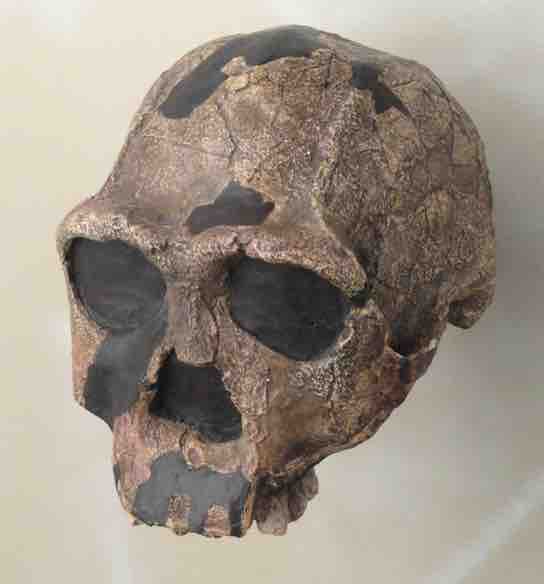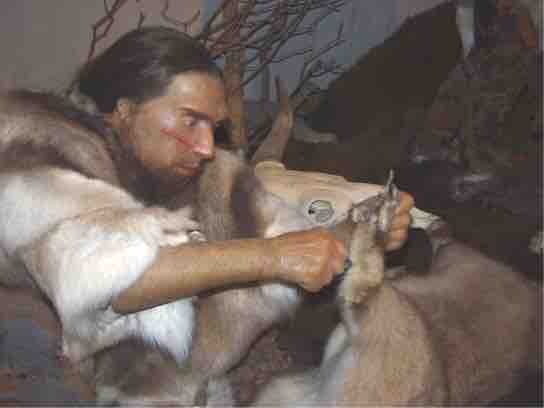Early Hominins: Genus Homo
The human genus, Homo, first appeared around 2.3 million years ago. For many years, fossils of a species called Homo habilis were the oldest examples in the genus Homo, but in 2010, a new species called Homo gautengensis was proposed that may be older, although it is not well accepted. In comparison to Australopithecus africanus, H. habilis had a number of features more similar to modern humans. H. habilis had a jaw that was less prognathic (forward projection of the jaw) than the australopiths and a larger brain, at 600–750 cubic centimeters. However, H. habilis retained some features of older hominin species, such as long arms. The name H. habilis means "handy man," which is a reference to the stone tools that have been found with its remains.
H. erectus appeared approximately 1.8 million years ago . It is believed to have originated in East Africa and was the first hominin species to migrate out of Africa. Fossils of H. erectus have been found in India, China, Java, and Europe, and were known in the past as "Java Man" or "Peking Man." H. erectus had a number of features that were more similar to modern humans than those of H. habilis. H. erectus was larger in size than earlier hominins, reaching heights up to 1.85 meters and weighing up to 65 kilograms, sizes similar to those of modern humans. Its degree of sexual dimorphism was less than earlier species, with males being 20 to 30 percent larger than females, which is close to the size difference seen in our species. H. erectus had a larger brain than earlier species at 775–1,100 cubic centimeters, which compares to the 1,130–1,260 cubic centimeters seen in modern human brains. H. erectus also had a nose with downward-facing nostrils similar to modern humans, rather than the forward facing nostrils found in other primates. Longer, downward-facing nostrils allow for the warming of cold air before it enters the lungs and may have been an adaptation to colder climates. Artifacts found with fossils of H. erectus suggest that it was the first hominin to use fire, hunt, and have a home base. H. erectus is generally thought to have lived until about 50,000 years ago.

Homo erectus
Homo erectus had a prominent brow and a nose that pointed downward rather than forward.
Humans: Homo sapiens
A number of species, sometimes called archaic Homo sapiens, apparently evolved from H. erectus starting about 500,000 years ago. These archaic H. sapiens had a brain size similar to that of modern humans, averaging 1,200–1,400 cubic centimeters. They differed from modern humans by having a thick skull, a prominent brow ridge, and a receding chin. Some of these populations survived until 30,000–10,000 years ago, overlapping with anatomically-modern humans .

Homo sapiens neanderthalensis Tools
The Homo sapiens neanderthalensis used tools and may have worn clothing.
There is considerable debate about the origins of anatomically-modern humans or Homo sapiens sapiens. As discussed earlier, H. erectus migrated out of Africa and into Asia and Europe in the first major wave of migration about 1.5 million years ago. The multiregional hypothesis holds that humans first arose near the beginning of the Pleistocene two million years ago and subsequent human evolution has been within a single, continuous human species. This species encompasses archaic human forms such as Homo erectus and Neanderthals as well as modern forms, which evolved worldwide to the diverse populations of modern Homo sapiens sapiens. The hypothesis contends that humans evolve through a combination of adaptation within various regions of the world and gene flow between those regions. Proponents of multiregional origin point to fossil and genomic data and continuity of archaeological cultures as support for their hypothesis.
The primary alternative hypothesis is the recent African origin of modern humans, which holds that modern humans arose in Africa around 100,000–200,000 years ago, moving out of Africa around 50,000–60,000 years ago to replace archaic human forms with limited interbreeding: at least once with Neanderthals and once with Denisovans.